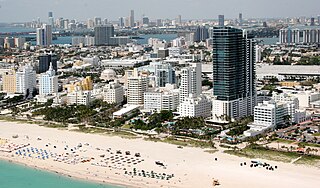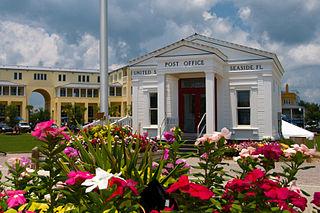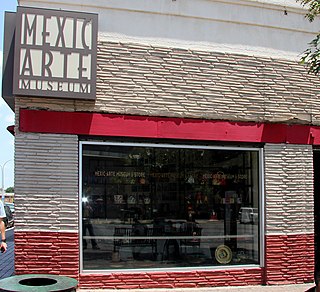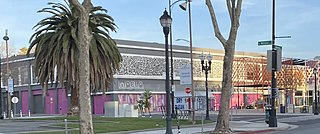
Guadalajara is a metropolis in western Mexico and the capital of the state of Jalisco. According to the 2020 census, the city has a population of 1,385,629, while the Guadalajara metropolitan area has a population of 5,268,642, making it the third-largest metropolitan area in the country. Guadalajara has the second-highest population density in Mexico, with over 10,361 people per square kilometer. Guadalajara is an international center of business, finance, arts, and culture, as well as the economic center of the Bajío region, one of the most productive and developed regions in Latin America.

Diego María de la Concepción Juan Nepomuceno Estanislao de la Rivera y Barrientos Acosta y Rodríguez, known as Diego Rivera, was a prominent Mexican painter. His large frescoes helped establish the mural movement in Mexican and international art.

Miami Beach is a coastal resort city in Miami-Dade County, Florida, United States. It was incorporated on March 26, 1915. The municipality is located on natural and man-made barrier islands between the Atlantic Ocean and Biscayne Bay, the latter of which separates the Beach from the mainland city of Miami. The neighborhood of South Beach, comprising the southernmost 2.5 square miles (6.5 km2) of Miami Beach, along with Downtown Miami and the Port of Miami, collectively form the commercial center of South Florida. Miami Beach's population is 82,890 according to the 2020 census. Miami Beach is the 26th largest city in Florida based on official 2019 estimates from the U.S. Census Bureau. It has been one of America's pre-eminent beach resorts since the early 20th century.

San José is the capital and largest city of Costa Rica, and the capital of the province of the same name. It is in the center of the country, in the mid-west of the Central Valley, within San José Canton. San José is Costa Rica's seat of national government, focal point of political and economic activity, and major transportation hub. San José Canton's population was 288,054 in 2011, and San José's municipal land area is 44.2 square kilometers, with an estimated 333,980 residents in 2015. Together with several other cantons of the central valley, including Alajuela, Heredia and Cartago, it forms the country's Greater Metropolitan Area, with an estimated population of over 2 million in 2017. The city is named in honor of Joseph of Nazareth.
Arte is a European public service channel that promotes cultural programming.

Seaside is an unincorporated master-planned community on the Florida Panhandle in Walton County, between Panama City Beach and Destin. One of the first communities in America designed on the principles of New Urbanism, the town has become the topic of slide lectures in architectural schools and in housing-industry magazines, and is visited by design professionals from all over the United States. On April 18, 2012, the American Institute of Architects's Florida Chapter placed the community on its list of Florida Architecture: 100 Years. 100 Places as the Seaside – New Urbanism Township.

Mexic-Arte Museum is a fine arts museum in Austin, Texas. The Mission of the organization is to enrich and educate the community through the presentation and promotion of traditional and contemporary Mexican, Latino, and Latino art and culture.

Darío Escobar is a Guatemalan artist.

José Chávez Morado was a Mexican artist who was associated with the Mexican muralism movement of the 20th century. His generation followed that of Diego Rivera, José Clemente Orozco and David Alfaro Siqueiros. Although Chávez Morado took classes in California and Mexico, he is considered to be mostly self-taught. He experimented with various materials, and was an early user of Italian mosaic in monumental works. His major works include murals at the Ciudad Universitaria, Secretaría de Comunicaciones y Transportes and Museo Nacional de Antropología in Mexico City as well as frescos at the Alhóndiga de Granaditas, which took twelve years to paint. From the 1940s on, he also worked as a cultural promoter, establishing a number of cultural institutions especially in his home state of Guanajuato including the Museo de Arte Olga Costa - José Chávez Morado, named after himself and his wife, artist Olga Costa.

Mapastepec is a town and municipality in the southeastern state of Chiapas, Mexico. Its name derives from the place name mapachtepec, "Hill of the Raccoon", a compound of the Nahuatl words mapachi ("raccoon") and tepetl ("mountain").

Costalegre is a series of different beaches, capes and bays of various sizes distributed alongside the Pacific Ocean on the western coastline of the Mexican state of Jalisco, between Puerto Vallarta, Jalisco and Manzanillo, Colima.

Humberto Calzada is a Cuban-American artist living in Miami, Florida, since 1960.
Jason deCaires Taylor is a British sculptor and creator of the world's first underwater sculpture park – the Molinere Underwater Sculpture Park – and underwater museum – Cancún Underwater Museum. He is best known for installing site-specific underwater sculptures that develop into artificial coral reefs, which local communities and marine life depend on. Taylor integrates his skills as a sculptor, marine conservationist, underwater photographer and scuba diving instructor into each of his projects. By using a fusion of Land Art traditions and subtly integrating aspects of street art, Taylor produces dynamic sculptural works that are installed on the ocean floor to encourage marine life, to promote ocean conservation and to highlight the current climate crisis.

Various types of visual arts developed in the geographical area now known as Mexico. The development of these arts roughly follows the history of Mexico, divided into the prehispanic Mesoamerican era, the colonial period, with the period after Mexican War of Independence, the development Mexican national identity through art in the nineteenth century, and the florescence of modern Mexican art after the Mexican Revolution (1910-1920).

FAHRENHEITº is a bimonthly magazine of contemporary art and lifestyle that addresses the theme from different disciplines of art, criticism and theory. It was founded in 2003 in Mexico City by Rubén José Marshall Tikalova. Its website was launched in 2009; in this site there can be found news from contemporary art and culture, in Spanish, English and French. The magazine is intended for a range of audiences. Both media and readers have found in FAHRENHEITº a means of staying in contact with the art world. The magazine has received coverage since 2003 in the press, magazines and catalogues, and in a research thesis.
Olga Dondé was a Mexican artist involved in various fields but best known her still life pieces. She was a self-taught painter, who worked for two years until she decided to enter works in a show in 1968. From then she had about 100 showings of her work, including more than forty individual exhibitions in Mexico, the United States, South Americana and Europe. She also founded artistic organizations, an art gallery and a publishing house. Dondé’s work was recognized by admission in the Salón de la Plástica Mexicana, among other honors and her work continues to be shown and honored after her death.
Pedro Pablo Preux was a Mexican tapestry maker of French origin, part of an effort to revive the craft as an art form in Europe under Jean Luçart then introducing and promoting the concept in Mexico in the 1960s and 1970s. Although tapestry making as art declined back to handcraft status starting in the 1980s, Preux’s efforts were recognized with membership in the Salón de la Plástica Mexicana and the Sistema Nacional de Creadores de Arte.

Julia López is a self-taught Mexican painter whose works depict her childhood home in the Costa Chica region of Guerrero state. She was born in a small farming village but left early for Acapulco and Mexico City to find a better life. In the capital, she was hired as a model for artists at the Escuela Nacional de Pintura, Escultura y Grabado "La Esmeralda" and as such became part of the circle of notable artists of that time. Their influenced encouraged her to draw and paint, with Carlos Orozco Romero discouraging her from formal instruction as to not destroy her style. She began exhibiting in 1958 and since then has exhibited individually and collectively in Mexico, the United States and Europe. Her work has been recognized with awards and membership in the Salón de la Plástica Mexicana.

The Museo Universitario Arte Contemporáneo, also known as MUAC, is a large contemporary art museum located within the main campus of the National Autonomous University of Mexico (UNAM). It opened in November 2008 and it is the first Mexican public museum exclusively focused to the arts created in the XXI century.

Movimiento de Arte y Cultura Latino Americana (MACLA) is a contemporary arts space focused on the Chicano and Latino experience and history, located in the SoFA district at 510 South First Street in San Jose, California. The museum was founded in 1989, in order to encourage civic dialog and social equity. The current programming includes visual art, performing and literary arts, youth arts education, and a community art program. The space has two performing arts spaces, a gallery and the MACLA Castellano Playhouse and they frequently host poetry readings and film screenings.















